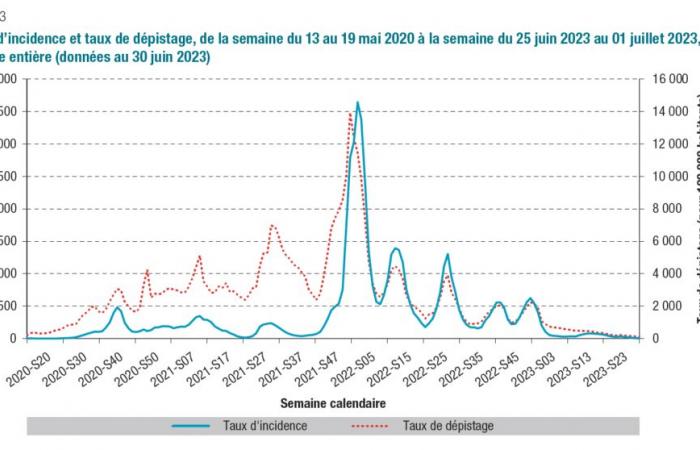SI-DEP, VAC-SI, Surv-ESMS… These acronyms punctuated the publications during the pandemic. Covid Coronavirus disease, sometimes referred to as coronavirus disease, is an illness caused by a coronavirus (CoV). The term may refer to the following diseases: severe acute respiratory syndrome (SARS) caused by the SARS-CoV virus, Middle East respiratory syndrome (MERS) caused by the MERS-CoV virus, coronavirus disease 2019 ( Covid-19) caused by the SARS-CoV-2 virus. 19. Public Health France devotes BEH from November 5, 2024 to “Information systems facing the Covid-19 pandemic: major challenges and legacies”, an important issue of around fifty pages which relates the implementation of systems or their adaptation in the health emergency , to guide decision-makers and implement the “test, alert, protect” strategy and slow the spread of the virus. A reference document for all those interested in health alert monitoring systems and their impact on the population and the health system.
“Several major challenges had to be met: 1) collect and analyze vast quantities of almost exhaustive data to describe viral circulation at the territorial level; 2) provide reliable and daily updated indicators, with the aim of enabling rapid and informed decision-making; 3) integrate a longitudinal vision of the data”, we can read in the editorial of this issue, signed by Laëtitia Huiart, who was scientific director of Public Health France from October 2020 to August 2024, and Caroline Alleaume, responsible at ‘agency.
Volume of data to be processed, transparency, interconnection between information systems, pseudonymization… The challenges linked to creation out of nothing tools are explored in the BEH. Thus, SI-DEP, the population screening information system, was set up on May 13, 2020 in a reactive manner, two months after the availability of the tests, to automatically receive all the test results (PCR , antigenic) carried out daily by all public and private laboratories, as well as authorized health professionals (main France and overseas departments)…
Ex nihilo or adapted devices
VAC-SI, the information system resulting from Vaccin Covid, constituting the database of vaccinations against Covid-19 Coronavirus disease, sometimes referred to as coronavirus disease, is an illness caused by a coronavirus (CoV). The term may refer to the following diseases: severe acute respiratory syndrome (SARS) caused by the SARS-CoV virus, Middle East respiratory syndrome (MERS) caused by the MERS-CoV virus, coronavirus disease 2019 ( Covid-19) caused by the SARS-CoV-2 virus. was also created quickly, but has undergone several developments to take into account places of residence, monitor vaccinations of health professionals and residents in nursing homes… while managing matching with the SI-DEP and SI databases -VIC. SI-VIC is a system triggered for exceptional situations. Created in 2015 in the context of Islamist attacks to ensure the identification and counting of victims, provide visibility of the impact of the event on the provision of care and facilitate support for victims and their loved ones, SI -VIC was enriched with individual and medical data to ensure real-time monitoring of hospitalizations linked to Covid at a time when the saturation of hospital capacities constituted a major indicator for the management of the pandemic.
Another information system created in the wake of the 2003 heatwave – where emergencies and funeral services were saturated – SurSaUD® (Syndromic Surveillance of Emergencies and Deaths), transmits daily in an automated manner, without selection, information on use of emergencies (Oscour), SOS doctors (SOSM) and deaths. It was necessary to add new codes to the existing ones characterizing Covid appeals and disseminate them throughout the emergency system to ensure homogeneous and reliable processing of Covid appeals. Thus, 722 emergency services, 62 associations of SOS doctors, 15,062 municipalities and 1,400 hospitals document SurSaUD.
New tools
Medical and social establishments, first and foremost nursing homes, have been dramatically impacted by Covid. There was no epidemiological information system for these establishments. Surv-ESMS was set up in all these establishments which included accommodation, to monitor the situation of people accommodated and staff and produce daily indicators of Covid attacks and deaths. This implementation in March 2020 and its gradual adaptation were a challenge in establishments that were poorly equipped and poorly trained in the IT tools required for such a system.
To approach the completeness and representativeness of the information obtained in real time, it is now a matter of testing the reliability of indicators from information systems. Orchid (Organization of a network of hospital centers involved in epidemiological surveillance and response to outbreaks) will “test the reactive production of specific indicators from the health data warehouses of hospital establishments”.
“Our ability to capitalize on the information systems deployed during the Covid-19 crisis is crucial to modernizing our routine surveillance systems more generally,” the editorial concludes. Because the pandemic, which has also revealed differentiated social impacts, and long-term impacts, particularly on mental health, suggests a need for more inclusive and interconnected surveillance systems to anticipate future public health crises from a “One-to-One” perspective. only health.”






